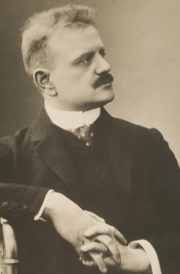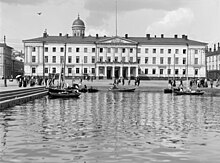Pan and Echo
| Pan and Echo | |
|---|---|
| Dance intermezzo by Jean Sibelius | |
 The composer (c. 1905) | |
| Native name | Pan och Echo |
| Opus | 53 |
| Composed | 1906 (1906) |
| Publisher | Lienau (1907)[1] |
| Duration | 4.5 mins.[1] |
| Premiere | |
| Date | 24 March 1906 (1906-03-24)[1] |
| Location | Helsinki, Grand Duchy of Finland |
| Conductor | Jean Sibelius |
| Performers | Helsinki Philharmonic Society |
Pan and Echo (in Swedish Pan och Echo; in Finnish: Pan ja Kaiku; subtitled "Dance intermezzo No. 3"),[1] Op. 53,[a] is tableau music for orchestra written in early 1906 by the Finnish composer by Jean Sibelius. The piece premiered in Helsinki on 24 March 1906, with Sibelius conducting the Helsinki Philharmonic Society; the venue was the original location of the Hotelli Seurahuone [fi] (Helsinki City Hall since 1913).[2][1]
Though brief, Pan and Echo is, according to Sibelius's biographer Andrew Barnett, "poetic, full of feeling, and scored with great sensitivity".[2]

Instrumentation
Pan and Echo is scored for the following instruments,[1] organized by family (woodwinds, brass, percussion, and strings):
- 2 flutes (one doubling piccolo), 2 oboes, 2 clarinets (in B♭), and 2 bassoons
- 4 horns (in F), 2 trumpets (in F), and 3 trombones
- Timpani, bass drum, cymbals, and triangle
- Violins (I and II), violas, cellos, and double basses
Discography
The Finnish conductor Martti Similä [fi] and the Finlandia Orchestra made the world premiere studio recording of Pan and Echo c. 1956 for Fennica.[1] The table below lists this and other commercially available recordings:
| No. | Conductor | Ensemble | Rec.[b] | Time | Recording venue | Label | Ref. |
|---|---|---|---|---|---|---|---|
| 1 | Martti Similä [fi] | Finlandia Orchestra | c. 1956 | ? | ? | Fennica | |
| 2 | Sir Charles Groves | Royal Liverpool Philharmonic Orchestra | 1975 | 4:27 | Philharmonic Hall, Liverpool | EMI Classics | |
| 3 | Neemi Järvi | Gothenburg Symphony Orchestra | 1986 | 4:33 | Gothenburg Concert Hall | BIS | |
| 4 | Stanislav Gorkovenko | Saint Petersburg Radio and TV Orchestra [ru] | ? | 4:21 | ? | Elap | |
| 5 | Shuntaro Sato | Kuopio Symphony Orchestra [fi] | 2002 | 4:29 | Kuopio Music Centre [fi] | Finlandia | |
| 6 | Osmo Vänskä | Lahti Symphony Orchestra | 2004 | 4:07 | Sibelius Hall | BIS | |
| 7 | Pietari Inkinen | New Zealand Symphony Orchestra | 2007 | 4:51 | Michael Fowler Centre | Naxos |
Notes, references, and sources
- Notes
- ^ Pan and Echo was published as Sibelius's Op. 53a. However, no work in his oeuvre retains the 'Op. 53b' designation.
- ^ Refers to the year in which the performers recorded the work; this may not be the same as the year in which the recording was first released to the general public.
- ^ [ M. Similä–Fennica (SS 1) 1968]
- ^ C. Groves–EMI Classics (85532) 2004
- ^ N. Järvi–BIS (CD–359) 1987
- ^ S. Gorkovenko–Elap (44183CD) 1998
- ^ S. Sato–Finlandia (0927–49598–2) 2003
- ^ O. Vänskä–BIS (CD–1565) 2006
- ^ P. Inkinen–Naxos (8.570763) 2008
- References
- ^ a b c d e f g Dahlström 2003, p. 245.
- ^ a b Barnett 2007, p. 175.
- Sources
- Barnett, Andrew (2007). Sibelius. New Haven: Yale University Press. ISBN 978-0-300-11159-0.
- Dahlström, Fabian [in Swedish] (2003). Jean Sibelius: Thematisch-bibliographisches Verzeichnis seiner Werke [Jean Sibelius: A Thematic Bibliographic Index of His Works] (in German). Wiesbaden: Breitkopf & Härtel. ISBN 3-7651-0333-0.
Also see
- Pan (god)
- Echo (mythology)
External links
- Pan and Echo (Pan och Echo), Op. 53: Scores at the International Music Score Library Project
- v
- t
- e
- Kullervo (1892)
- Symphony No. 1 (1899, rev. 1900)
- Symphony No. 2 (1902)
- Symphony No. 3 (1907)
- Symphony No. 4 (1911)
- Symphony No. 5 (1915, rev. 1916, 1919)
- Symphony No. 6 (1923)
- Symphony No. 7 (1924)
- Symphony No. 8 (mid 1920s–c. 1938, abandoned)
- Violin Concerto (1904, rev. 1905)
- Two Serenades (1912–1913)
- Two Serious Melodies (1914–1915)
- Six Humoresques (1917–1918, No. 1 rev. 1940)
- Suite for Violin and String Orchestra (1929)
- En saga (1892, rev. 1902)
- Spring Song (1894, rev. 1895)
- The Wood Nymph (1895)
- Lemminkäinen Suite
- 1895, rev. 1897, 1900, 1939; includes The Swan of Tuonela
- Finlandia (1899)
- Pohjola's Daughter (1906)
- Nightride and Sunrise (1909)
- The Dryad (1910)
- The Bard (1913)
- Luonnotar (1913)
- The Oceanides (1914, rev. 1914)
- Tapiola (1926)
- The Building of the Boat (1893–1894, abandoned)
- The Maiden in the Tower (1896)
- King Christian II (1898)
- Kuolema
- 1903; includes Valse triste
- Pelléas et Mélisande (1905)
- Belshazzar's Feast (1906)
- Swanwhite (1908)
- The Lizard (1909)
- The Language of the Birds (1911)
- Scaramouche (1913)
- Everyman (1916)
- The Tempest (1925)
- Cantata for the University Graduation Ceremonies of 1894
- Cantata for the Coronation of Nicholas II (1896)
- Cantata for the University Graduation Ceremonies of 1897
- The Origin of Fire (1902, rev. 1910)
- The Captive Queen (1906)
- My Own Land (1918)
- Song of the Earth (1919)
- Hymn of the Earth (1920)
- Väinämöinen's Song (1926)
- The Rapids-Rider's Brides (1897)
- The Breaking of the Ice on the Oulu River (1899)
- Snöfrid (1900)
- Marjatta (1905, abandoned)
- Impromptu (1902, rev. 1910)
- The Raven (1910, abandoned)
- Overture in E major (1891)
- Ballet Scene (1891)
- Karelia Suite (1893)
- Rakastava (1894, arr. 1912)
- Scènes historiques I (1899, arr. 1911)
- Overture in A minor (1902)
- Romance in C major (1904)
- Cassazione (1904, rev. 1905)
- Pan and Echo (1906)
- In memoriam (1909, rev. 1910)
- Scènes historiques II (1912)
- Suite mignonne (1921)
- Suite champêtre (1922)
- Suite caractéristique (1922)
- String Quartet in E-flat major (1885)
- String Quartet in A minor (1889)
- String Quartet in B-flat major (1890)
- String Quartet in D minor, Voces intimae (1909)
- Andante festivo (1922, orch. 1938)
- Piano Trio in A minor, Hafträsk (1886)
- Piano Trio in D major, Korpo (1887)
- Piano Trio in C major, Lovisa (1888)
- Water Droplets (c. 1875–1881)
- Pieces for brass septet (1889–1899)
- Piano Quintet (1890)
- Malinconia (1900)
- Violin Sonatina (1915)
- Six Impromptus (1893)
- Piano Sonata (1893)
- Ten Pieces, Op. 24 (1895–1903)
- Kyllikki (1904)
- Three Sonatinas (1912)
- The Bells of Kallio Church (1912, arr. 1912)
- Two Rondinos (1912)
- Five Pieces, The Trees, Op. 75 (1914)
- Five Pieces, The Flowers, Op. 85 (1916–1917)
- Five Esquisses (1929)
- Seven Runeberg Songs, Op. 13 (1891–1892)
- "Serenad", JS 168 (1894–1895)
- Six Songs, Op. 36 (1899–1900)
- Five Songs, Op. 37 (1900–1902)
- Seven Songs, Op. 17 (1891–1904)
- Five Songs, Op. 38 (1903–1904; includes "Höstkväll")
- Six Songs, Op. 50 (1906)
- Two Songs, Op. 35 (1908)
- "Kom nu hit, död", Op. 60/1 (1909, orch. 1957)
- "Arioso", Op. 3 (1911)
- Five Christmas Songs, Op. 1 (1897–1913; includes "Giv mig ej glans, ej guld, ej prakt")
- Six Runeberg Songs, Op. 90 (1917)
- Hymn, Op. 21 (1896, rev. 1898)
- Songs for Mixed Chorus from the 1897 Promotional Cantata (arr. 1898)
- Finlandia Hymn (1899, arr. 1938–1940)
- Six Partsongs, Op. 18 (1893–1901)
- Jäger March (1917)
- Ainola (home)
- Aino Sibelius (wife)
- Ruth Snellman [fi] (daughter)
- Heidi Blomstedt (daughter)
- Christian Sibelius (brother)
- Aulis Blomstedt (son-in-law)
- Jussi Jalas (son-in-law)
- Jussi Snellman [fi] (son-in-law)
- Alexander Järnefelt (father-in-law)
- Elisabeth Järnefelt (mother-in-law)
- Armas Järnefelt (brother-in-law)
- Arvid Järnefelt (brother-in-law)
- Eero Järnefelt (brother-in-law)
- Kasper Järnefelt [fi] (brother-in-law)
- Helsinki Music Institute: Martin Wegelius (theory, composition)
- Mitrofan Vasiliev (violin)
- Hermann Csillag [de] (violin)
- Post-graduate studies: Albert Becker
- Robert Fuchs
- Karl Goldmark
- Toivo Kuula
- Leevi Madetoja
- Bengt de Törne [fi]
- Juhani Aho
- Aino Ackté
- Granville Bantock
- Ferruccio Busoni
- Axel Carpelan [fi] (patron)
- Olin Downes
- Ida Ekman
- Richard Faltin [fi]
- Ida Flodin [fi]
- Karl Flodin [fi]
- Akseli Gallen-Kallela
- Heikki Klemetti [fi]
- Santeri Levas (secretary)
- Erkki Melartin
- Oskar Merikanto
- Rosa Newmarch
- Abraham Ojanperä
- Selim Palmgren
- Adolf Paul
- Wilhelm Stenhammar
- Karl Wasenius [fi]
- Fabian Dahlström [fi]
- Karl Ekman [fi]
- Erik Furuhjelm [fi]
- Glenda Dawn Goss
- Cecil Gray
- Robert Layton
- Nils-Eric Ringbom [fi]
- Erik W. Tawaststjerna
- International Jean Sibelius Violin Competition
- Jean Sibelius Quartet
- Sibelius (2003 film)
- Sibelius (scorewriter)
- Sibelius Academy
- Sibelius Academy Quartet
- Sibelius Glacier
- Sibelius Hall
- Sibelius Medal
- Sibelius Monument
- Sibelius Museum
- Sibelius Piano Trio
- Sibelius Society of Finland
- 1405 Sibelius (asteroid)
- Wihuri Sibelius Prize
 Category
Category









